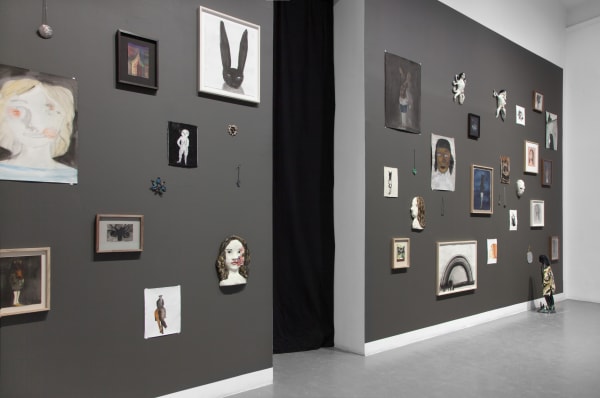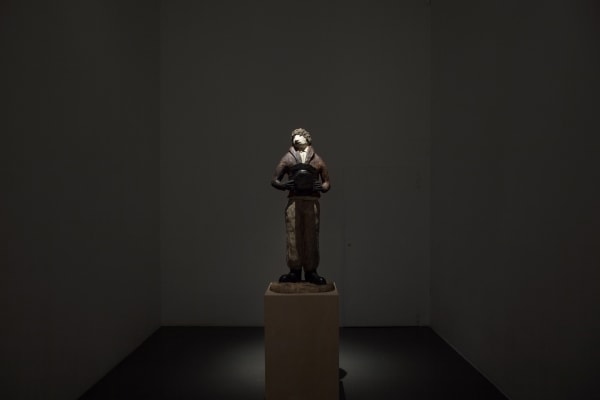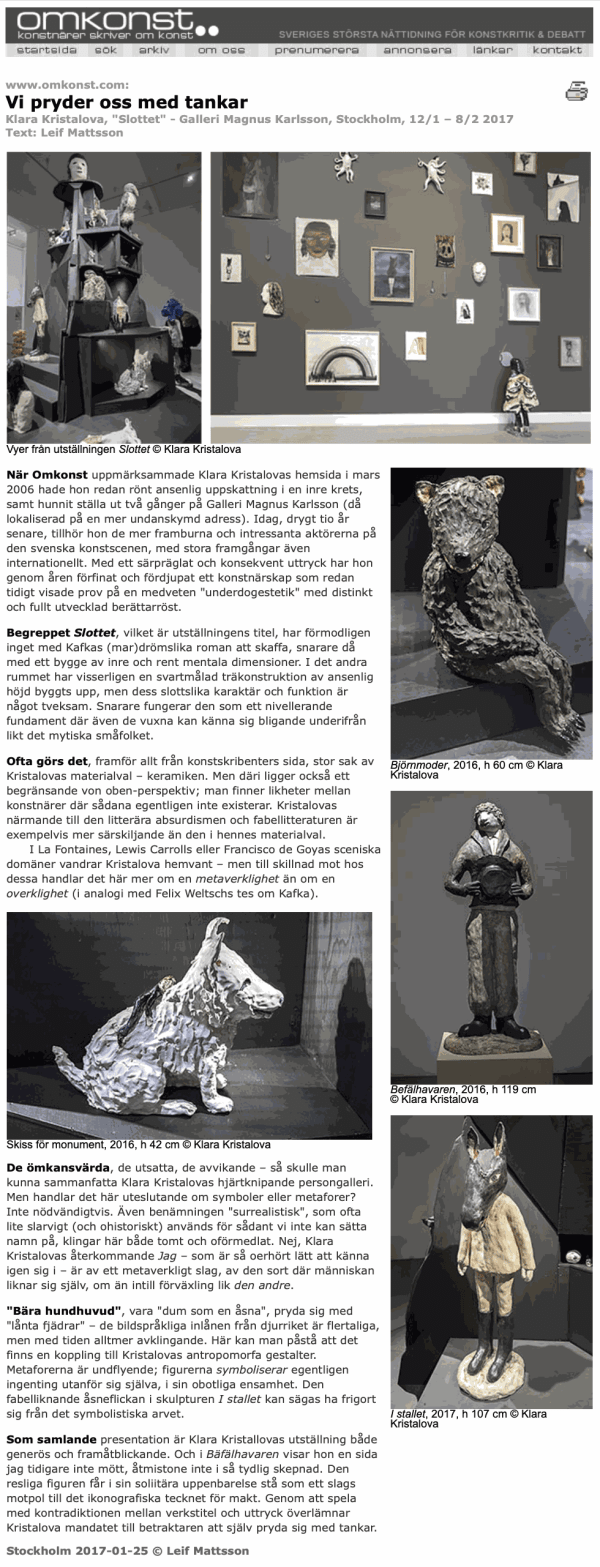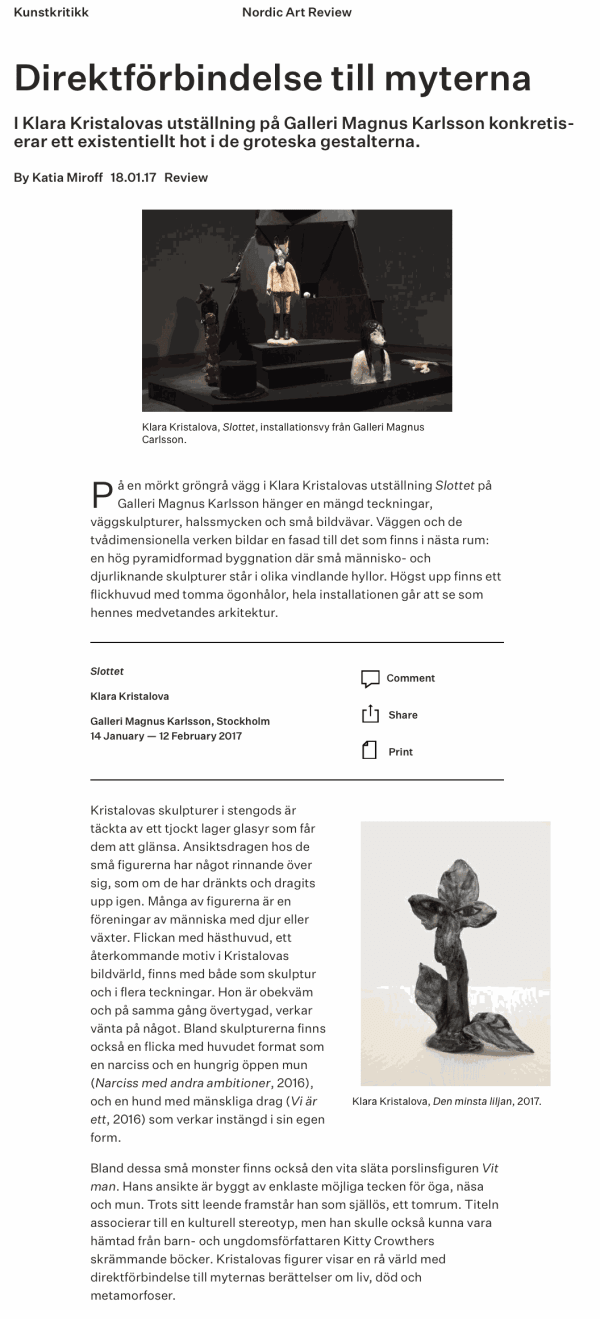Klara Kristalova | Slottet
(Scroll down for Swedish)
We have the pleasure to present Klara Kristalova’s fifth solo exhibition at the gallery. Her last major presentation in Stockholm was an acclaimed exhibition at Bonniers Konsthall in 2012. During the last ten years she has established herself as one of Sweden’s most successful artists with exhibitions in galleries and museums around the world. She now returns with a site-specific installation made for the gallery called Slottet (The Castle) – a structure that can be seen as a mixture of a tower, a mountain and a body – which collects a number of ceramic sculptures. It holds associations and reflections of both our society and the personal inner life. The installation is built in the main room of the gallery. The exhibition also present a wall with different works in various materials, such as: textiles, drawing, watercolor, relief and smaller jewelry-like objects in silver, which are all connected to Slottet (The Castle).
The artist and writer Andreas Mangione (b. 1974) has written the following text about Klara Kristalova’s work after a studio visit and conversation with the artist.
Keep on Digging for Clay in the High Hills
Between the creation of the cave paintings and the first fledgling attempts at writing, the Earth completed approximately 30,000 orbits around the Sun. As permanent settlers, man had achieved a new order, and this order demanded an administration, which in turn needed a new tool. Of the oldest writings in existence, most have to do with lists and laws. Without law and order, no royal palace, without a registry for trade transactions and possessions, no castle. But there is also another type of writing from the early civilisations that exists in copious amounts, namely texts that deal with the practice of religion and the relationship between the sacred and the profane; on the transformations that take place and the boundary between a beginning and an end.
This is where it starts for me. In reflecting on the relationship between castle and writing.
Birth in the Greenhouse[1]. The water creature, the greenhouse as metaphor for birth and early childhood. An exceptionally fragile phase in total dependence on others. Uncertainty and hope. The Discothèque[2] is the school of life, the labyrinth built on precise blueprints based on the footsteps of the dance-obsessed princesses. The transformation takes place in the dancing itself, dance dance dance, everything quivers in the bath, in the forest, in the cabin. The palace of Knossos, where the entity that became stuck in mid-transformation was forever locked away. Neither man nor beast, but rather a new form, totally alone, and as such, also feared. The Mortuary[3] is the book, the final account, the writing and narrative of life. A letter is a grave, an empty shape where the sound from larynx and lip lies dead. Death as transformation. It is here, in the mortuary, that the defining struggle over life takes place, the struggle for the stories of what life really is.
This is an open castle – anyone in the vicinity is welcome to come by for a visit.
The piece The Castle is built along a vertical axis. The wandering proceeds in circles, it is an open construction where inside and outside constantly and imperceptibly trade places with each other. These shifts, this exchange of elements from the inside to the outside take place at varying speeds. Transformations are an addiction, and whether they occur or not depends both on the amount of time the visitors are ready to invest and the extent to which they are willing to shift the focus away from the static object. The Castle is not simply a collection of individual items to look at.
Odd as it might seem, the more intently I look at Klara Kristalova’s works, the more I feel listened to, and aided in formulating my impressions, my life here and now. It’s not as though The Castle thinks for me, but in a simple and direct manner the piece offers me the means to answer, to reply to the sensitivity and rawness in the hand moulded material, and to access the story therein. I see The Castle as a collage of sorts, or perhaps even better, as a tapestry, woven out of its unusually large blueprint and the existing maps of the high surrounding hills. And then there are the details: porcelain clay becomes flower petals, animal hair and claws; becomes darkness, dry skin, and deep, deep eyes. I see fluttering tent canvas and an irrepressible backbone that listens. And I say: Remember this hut.
Andreas Mangione
---
[1, 2, 3] While visiting Klara Kristalova’s studio, I catch sight of a piece of paper where she has written the following: The Greenhouse – The Discothèque – The Mortuary.
---
Klara Kristalova, b.1967 in Prague, Czech Republic. Lives and works outside of Norrtälje, Sweden. Selected Solo Exhibitions: Galerie Perrotin, Hong Kong (2016), Norton Museum of Art, West Palm Beach, USA (2014) Lehmann Maupin, New York, USA (2014), Hunt Kastner, Prague, Czech Republic (2014), Galerie Perrotin, New York, USA (2014), Bror Hjorths Hus, Uppsala, Sweden (2014), Göteborgs Konstmuseum, Sweden (2013), Västerås Konstmuseum, Sweden (2013), Bonniers Konsthall, Stockholm, Sweden (2012), Galerie Perrotin, Paris, France (2012), San Francisco Museum of Modern Art, USA (2011), Galleri Magnus Karlsson, Stockholm, Sweden (2010, 2007, 2004, 2002), Galerie Perrotin, Miami, USA (2007).
Vi har glädjen att presentera Klara Kristalovas femte separatutställning på galleriet. Hennes senaste större presentation i Stockholm var en uppmärksammad utställning på Bonniers Konsthall 2012. Under de tio senaste åren har hon etablerat sig som en av Sveriges internationellt mest framgångsrika konstnärer med utställningar på gallerier och museer runt om i världen. Hon återkommer nu med en platsspecifik installation för galleriet kallad Slottet – en konstruktion som kan ses som en blandning av ett torn, ett berg och en kropp – som samlar en större mängd skulpturer i keramik. Den rymmer associationer och reflektioner både av vårt samhälle idag och det personliga inre livet. Installationen är placerad centralt i galleriets andra rum. I det första rummet visas en vägg med skilda arbeten i olika material, bl.a. textil, teckning, akvarell, relief och mindre smyckesliknande objekt i silver, som anknyter till Slottet.
Konstnären och skribenten Andreas Mangione har efter ett ateljébesök och samtal med konstnären skrivit en text om hennes arbeten.
---
Fortsätt gräva i den höga kullen efter lera.
Mellan grottmålningarna och de första skrifttecknen snurrade jorden ca 30.000 varv runt solen. Som bofast byggde människan en ny ordning, och denna ordning krävde en administration som i sin tur behövde ett nytt verktyg. Av de äldsta texterna som finns bevarade är de allra flesta listor och lagar. Utan lag och ordning inget kungligt palats, utan register för handelstransaktioner och egendom inget slott. Men det finns också en annan typ av text från de tidiga civilisationerna, och det i enorma mängder. Det är texter som behandlar religionsutövning och möten mellan det heliga och det profana; om förvandlingarna som sker och om gränsen mellan en början och ett slut.
Det är här det börjar för mig. I att tänka på relationen mellan slott och text.
Födelsen i Växthuset[1]. Vattenvarelsen, växthuset som födelse och den tidiga barndomen. En mycket delikat tid i allra största beroende av andra. Ovisshet och hopp. Diskoteket[2] är livets skola, labyrinten som byggdes från exakta ritningar över de danstokiga prinsessornas fotsteg. I dansen sker förvandling, dans dans dans, allt darrar i badet, i skogen, i kojan. Palatset i Knossos i vilket den som fastnat mitt i mellan en förvandling låstes in. Varken människa eller djur, utan istället en ny form och totalt ensam. Och som ensam och ny också fruktad. Bårhuset[3] är boken, bokslutet, texten och berättelsen om livet. En bokstav är en grav, en tom form där ljudet från strupe och läpp ligger död. Döden som förvandling. Det är här på bårhuset som den avgörande kampen om det levande utspelar sig, kampen om berättelserna om vad det verkliga är.
Detta är ett öppet slott – alla som har vägarna förbi är välkomna att besöka det.
Verket Slottet är byggt kring en lodrät axel. Vandringen går i cirklar, det är en öppen konstruktion där insida och utsida ständigt och omärkligt byter plats med varandra. Dessa skiftningar, detta utbytande av bitar från insida och utsida, sker i olika hastigheter. Förvandlingar är ett beroende, och om de ska ske så hänger det på hur mycket tid den besökande är redo att investera samt vilken makt besökaren ger viljan att släppa taget om tanken på det statiska objektet. Slottet är inte bara en samling enskilda saker att titta på.
Det kan låta märkligt men jag upplever att ju noggrannare jag tittar på Klara Kristalovas verk, desto mer blir jag lyssnad på och hjälpt med att formulera mina intryck – mitt liv här och nu. Det är inte så att Slottet tänker åt mig, men på ett enkelt och direkt vis erbjuder verket mig möjligheten att svara. Svara på en känslighet och en råhet i ett formgivet material, och på berättelsen som finns i denna behandling. Jag tänker att Slottet är ett kollage eller kanske bättre, det är en väv, flätad av dess ovanligt stora planritning och av de kartor som finns över de höga kullarna runtomkring. Och så detaljerna: porslinslera blir blomblad, djurhår och klor. Blir mörker, torr hud och djupa, djupa ögon. Jag ser darrande tältduk och en okuvlig ryggrad som lyssnar. Och jag säger: Minns denna koja.
Andreas Mangione
---
[1, 2, 3] I Klara Kristalovas ateljé få jag syn på en papperslapp där hon skrivit Växthuset – Diskoteket – Bårhuset.
---
Klara Kristalova, f.1967 i Prag. Bor och arbetar utanför Norrtälje. Separatutställningar i urval: Galerie Perrotin, Hong Kong (2016), Norton Museum of Art, West Palm Beach, USA (2014) Lehmann Maupin, New York (2014), Hunt Kastner, Prag (2014), Galerie Perrotin, New York (2014), Bror Hjorths Hus, Uppsala (2014), Göteborgs Konstmuseum (2013), Västerås Konstmuseum (2013), Bonniers Konsthall (2012), Galerie Perrotin, Paris (2012), San Francisco Museum of Modern Art, USA (2011), Galleri Magnus Karlsson, Stockholm (2010, 2007, 2004, 2002), Galerie Perrotin, Miami, USA (2007).
Läs en recension i SvD
Läs en recension i DN
Läs en recension på kunstkritikk.se
Läs en recension på omkonst.com
Läs en recension på www.konsten.net
Läs en recension i Norrtälje tidning








